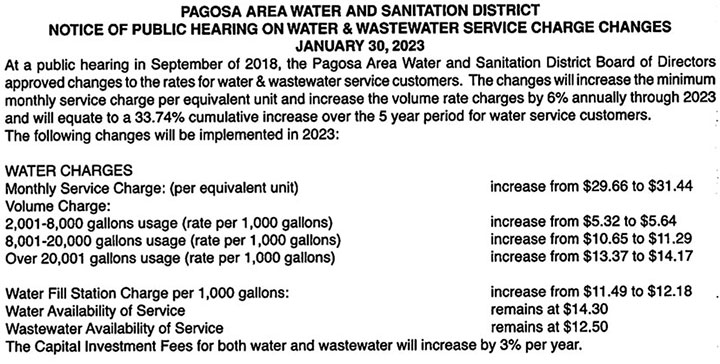This is a tale of two water districts in Archuleta County… one with an annual budget of about $90,000… the other with an annual budget of about $38 million.
Both districts presumably want to do their very best, for their constituents. For the taxpayers.
But they are headed in rather different directions.
Earlier this week, on January 23, a group of thoughtful Archuleta County citizens voted unanimously to define the “target size” of an unpopular water reservoir project — the Dry Gulch Reservoir, also known as the San Juan River Headwaters Project — at 11,000 acre feet.
The citizens in question, who agreed on this project’s ideal size, are the members of the San Juan Water Conservancy District (SJWCD) board of directors — volunteers who are appointed to serve by a district court judge.
When joining the district, these citizens made a commitment to further the goals of the Conservancy District.
Whether those goals reflect the desires of the Archuleta County taxpayers is less clear. As far as I can tell — having myself previously served on the SJWCD board — the District has never made a serious attempt to discover the true opinions of the taxpayers regarding the development of a 11,000 acre-foot reservoir.
I’m defining the Dry Gulch project as “unpopular” based on anecdotal evidence. More about that in a moment.
Since 2008, the property designated as the site for the Dry Gulch Reservoir has been the 660-acre Running Iron Ranch, located about 2 miles northeast of downtown Pagosa Springs, along Highway 160. The site was purchased for about $10 million, of which $9 million consisted of money borrowed by another local water district, Pagosa Area Water and Sanitation District (PAWSD). PAWSD delivers drinking water to a vast majority of Archuleta County’s residents (and visitors)… and PAWSD customers are responsible for paying back that $9 million loan. Since 2015, PAWSD customers have also been committed to paying back a $1 million grant originally awarded to SJWCD — if the Dry Gulch Reservoir is not constructed.
Disclosure: I currently serve on the PAWSD Board of Directors, but this editorial series reflects only my personal opinions, and not necessarily the opinions of the PAWSD Board as a whole.
In 2009, following the purchase of the Running Iron Ranch, PAWSD and SJWCD downsized the proposed reservoir from 35,000 acre-feet to 25,300 acre-feet. To put that volume into perspective, 25,300 acre-feet is about 20 times the amount of water sold to all PAWSD customers and visitors and fill-station customers in 2021.
Also in 2009, PAWSD and SJWCD hired an engineering firm to estimate the cost of the proposed reservoir project, and were given the figure $357 million. As proposed in 2009, PAWSD customers were expected to pay the lion’s share of of the $357 million cost.
But the following year, 2010, a Supreme Court decision and some backroom negotiations with sportsmans organization Trout Unlimited caused PAWSD and SJWCD to reduce the proposed size to 11,000 acre-feet. (Still about 10 times the amount of PAWSD water sold in 2021.)
I refer to the negotiations as “backroom” because the taxpaying public had zero input into the the 11,000 acre-foot stipulation.
Unlike the directors of SJWCD, who are appointed by a judge, the PAWSD board is elected by its customers. As far as I can tell, since 2010, no one elected to the PAWSD Board has been a proponent of an 11,000 acre-foot reservoir at Dry Gulch.
An indication of taxpayer sympathies? Perhaps.
Then in 2017, the SJWCD board proposed, to the voters, a mill levy increase aimed at building an 11,000 acre-foot reservoir. The measure lost by a 3-to-1 margin… (879 ‘For’, 2705 ‘Against’).
Another indication of how the taxpayers feel about Dry Gulch? Possibly so.
History can be informative, if we bother to consider it.
Having served on the SJWCD board for four years, I believe the Conservancy District’s lack of interest in taxpayer opinions has allowed the board to throw their support behind a massive water project that most of their constituents don’t support.
Meanwhile, the taxpayer-funded organization responsible for paying off the $10 million Dry Gulch property purchase — PAWSD — will be holding its January board meeting this coming Monday, January 30, at 5pm at the PAWSD offices. The public is invited and — if tradition holds — will be listened to.
Yes, there will be a public hearing on rate increases. And a public hearing on a relatively large loan for the Vista Wastewater Treatment Plant.
Water is slowly becoming more expensive. A heavier burden.
Ditto, wastewater.

The Monday PAWSD agenda is somewhat heavy.
Approval of December 15, 2022, Minutes
Public Comment
Public Hearing on 2023 Water & Wastewater Rate Increases
Consideration of 2023 Water & Wastewater Rate Increases
Consideration of 2023 Connection Charges & Adjustments to Other Non-Rate Revenue
Consideration & Approval of 2023 Board Meeting Schedule
Consideration of Resolution 2023-01 Board Posting for Meetings
Public Hearing for Vista Wastewater Treatment Plant Modification Loan
Consideration of Grant Consulting Contract
Consideration of an Election Consulting Contract
Consideration of Resolution 2023-02 Calling for an Election
Discussion of a Workforce Housing Fee Waiver Template
Consideration of a Contribution to San Juan Headwaters Forest Health Partnership
Manager’s Talking Points
Any Other Business Brought Before the Board will be Duly Considered
(You can download the packet here. The rate studies are here.)
A number of these agenda items are just bookkeeping matters.
But a couple of them could have long-range impacts on the cost of water and wastewater, and on the growth of our community — or lack thereof.
How heavy might those impacts be?
